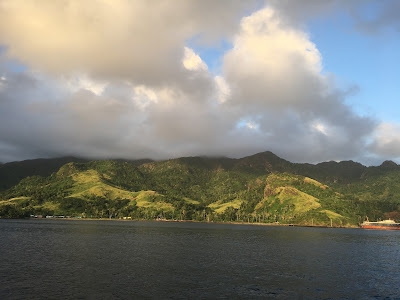Day 2 of a 7-day Fiji Islands cruise
Overnight
we travelled to the port of Levuka, a USESCO world heritage site on the island
of Ovalau. Europeans first settled in this area of Fiji and established it as
the capital around 1800. In 1888, the capital was moved to Suva on the main
island, but the town has retained its colonial architecture, although much of
it is in disrepair.
Before
arriving into port, my first early morning view was of the island’s lush
greenery. However, a crew member explained that last year’s Cyclone Winston, a category 5 cyclone, devastated many areas of Fiji. He explained that after the cyclone, this area
was depressingly bleak with no greenery at all. Some areas of Fiji still have
not recovered. In town, we did see examples of damaged buildings that have yet
to be repaired.
Our cruise
includes a scheduled agenda on land each day. In the morning, we went to the
home of Bubu Kara (‘bubu’ is Fijian for grandmother) who shared the legends of
the early settlers; their arrival, the power of the chiefs, the battles between
the tribes, and details of the cannibalism. These stories have been handed down
from generation to generation over the years. A translator from the ship came
with us, and Bubu Kara was happy to answer our questions.
She invited
those who were interested to see inside her home. Although most homes on the
island have electricity and running water, the home had little in the way of
furniture and the kitchen and wash area were very primitive. The building next
to theirs was in shambles from the cyclone.
Bubu Kara
is famous for her scones and handmade guava jam and she and her neighbours provided
delicious tea and scones for us.
Back to the
ship for lunch. After lunch, we were taken to the first school to be established
in Fiji. We were entertained by the students. This particular cruise – the
colonial cruise – only runs a few times a year, so these children put on a concert
like this about every four months.
The
children had prepared intricate necklaces of fresh flowers for each of us, and lined
up to put them on us. It was very touching.
Then they sang songs, in Fijian and English, while the teacher played guitar and some of the students played their wooden carved-out drums. Notice the teacher on the right is wearing what looks like a skirt. It's called a sulu, and is the equivalent of a lady's sarong. They are traditionally worn by those in authority, as in a teacher, or for special occasions. Many also wear them as their usual form of dress. Many of the male passengers on the ship are wearing a sulu some evenings, along with the 'bula shirt', which you can also see worn by the teacher on the right.
A group of
girls danced, and you can see an example of the costumes on this student. The
boys danced separately from the girls. The class accompanied the dancers by
singing.
Many of the students also wore face or body paint. This boy’s face was blackened on the one side only.
Three boys
played the large conch shells as wind instruments, and they sounded wonderful.
One was happy to pose for me, and his friends quickly jumped into the photo.
The children were amazing.
This school
has been able to make improvements thanks to the support of Captain Cook
Cruises. Many of the cruisers bring school supplies or donate money, and the
cruise line itself supports the school. The principal said that a stage would
be built in time for the next concert, thanks to such donations. We thoroughly
enjoyed this concert and loved the enthusiasm of the students.








No comments:
Post a Comment